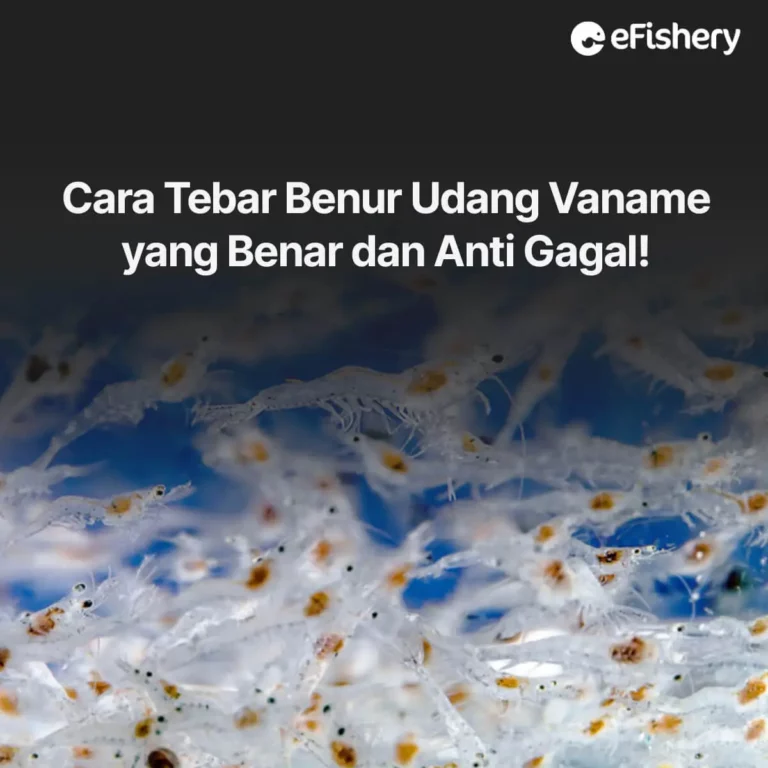Artikel Ini Telah Direview Oleh:

Eko Afriantoro
Praktisi Budidaya Udang
How to spread vannamei shrimp fry is one of the crucial stages in shrimp cultivation. The condition of the fry determines the success of the harvest that you will get. Good and correct stocking of fry can maintain the survival rate or Survival Rate (SR) shrimp remained high. Shrimp fry must be at PL 7 to PL 10 before being spread to ponds. So, you must ensure the quality of fry with a survival rate of not less than 95% after experiencing transportation from hatchery to the pond location.
Therefore, you need to understand how to spread shrimp fry in order to get the maximum harvest!
Characteristics of Good Benur
One of the success factors for vannamei shrimp farming is determined by the quality of the fry used. Quality fries certainly have a greater success rate when cultivating. Therefore, before sowing the fry into the pond, you are strongly advised to observe and sort the fry that will be used. This is useful for ensuring that only the best fry will be cultivated.
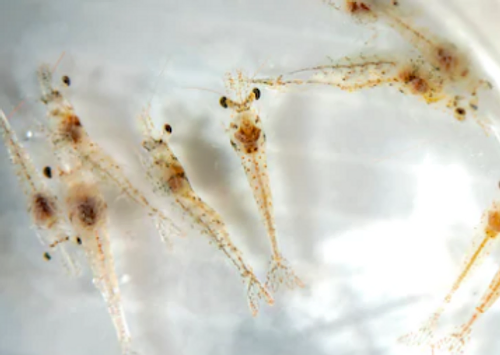
The following are the characteristics of the best quality fry for the success of vannamei shrimp cultivation:
- Age Enough Enough
Fry fry can be said to be ready for stocking when they are PL 7 to PL 10. If fry are old enough to be stocked, the survival rate or Survival Rate (SR) shrimp remained high. - Uniform Size
Good quality vannamei shrimp fry can be seen directly. Its characteristic is that the size is uniform between one fry and another. The non-uniform size of the fry indicates stunted fry growth. If you keep cultivating it, then harvesting vannamei shrimp cannot be done simultaneously, so you don't get the maximum profit. - Perfect Body Shape
You can see healthy and quality fry from their body shape. Quality fry have a straight body shape when swimming. While the body of fry that are not healthy will tend to bend. You can also observe the eyes and skin of the fry. Quality fry eyes tend to be shiny and the body skin does not have spots. - Whole Antenna
Quality fry have complete and intact antennae, not broken, and can open or close. If you see that the fry's antennae are always open, then you can be sure that the vannamei shrimp fry are not healthy. - Fully Filled Intestine
The condition of the fry intestine that is always full is a marker of quality fry. This is due to the digestive system running normally. In sick or stressed conditions, fry have an empty intestine, because their appetite is decreasing.
It's easy enough to find out if shrimp intestines are filled or not, you need to do this sampling and observe the condition of his intestines. Because the color of the fry is transparent, you have no difficulty in detecting the condition of the fry's intestines. - Opening Tail
Fry fry that are of good quality and ready to be stocked in ponds have an open tail. If not, you should delay stocking fry and wait for the tails to open. - Active swimming fry
Healthy vaname shrimp fry look active in swimming and are very sensitive to external stimuli. Healthy fry have a swimming pattern against the current and stick to the bottom of the pond when water moves.
The Right Way to Spread Vaname Shrimp Benur
When starting shrimp farming, you will go through several processes that must be carried out. If you do not carry out one of the processes properly, the growth of the shrimp will be disrupted and increase the risk of loss.
One of the most important stages to do is the seed stocking stage. By stocking good fry, you will reduce the mortality rate of shrimp, so that the potential for maximum harvest.
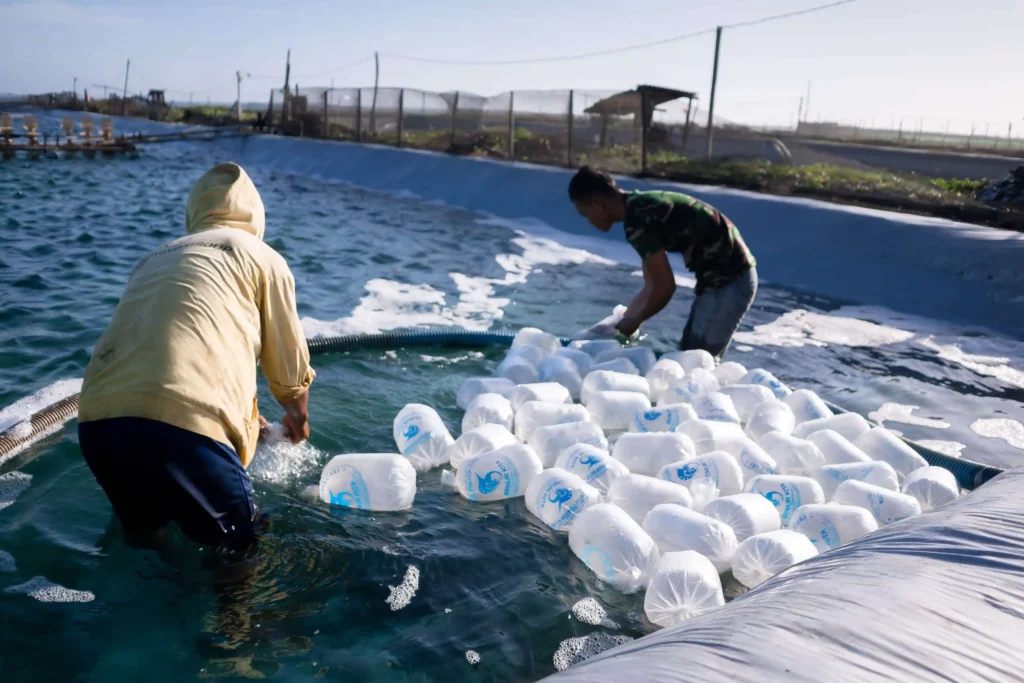
In the process of stocking fry, you must pay attention to the temperature of the environment around the fry, to be precise when the fry are in plastic. This is because the success of stocking fry is strongly influenced by the temperature adjustment between the plastic fry and the pond environment.
Generally, the temperature on plastic fry tends to be low. Therefore, you need to do the stocking in the morning or evening. This is because the pond temperature is still in low condition. Before the fry are transferred from the plastic bag to the pond, they need to be acclimatized first. Vannamei shrimp acclimatization is intended to prevent the high fry mortality rate during and after stocking.
Here's how to spread vannamei shrimp fry:
- Float the Benur Plastic on the Surface of the Pond
The first process of spreading fry is to float the plastic fry on the surface of the pond. After that, you can wait 15-30 minutes for the fry in the plastic bag to adapt to the pond environment. - Temperature Acclimatization
Aklimatisasi terhadap suhu dapat Bapak/Ibu lakukan dengan merendam kantong plastik yang telah berisi benur dalam keadaan tertutup hingga adanya uap di dalam kantong plastik tersebut. Hal tersebut menunjukkan bahwa suhu di dalam kantong plastik sudah sama dengan suhu air tambak. Kemudian, benur bisa langsung dikeluarkan dari kantong benur.
The stocked fry have different densities depending on the cultivation technique used and the size of the pond. The following are recommended stocking densities:
- Extensive (low) cultivation, recommended stocking density < 50 shrimp/m³.
- For semi-intensive (medium) cultivation, the recommended stocking density is 50-100 shrimp/m³.
- Intensive cultivation (high), recommended stocking density > 100 shrimp/m³.
Proper stocking density will optimize shrimp growth. This relates to the competition for feed that occurs in ponds and carrying capacity or the ability of the pond system to accommodate shrimp activity.
You can do the seed stocking activity in the morning or evening at the same time as stocking artemia as the fry's natural food. In addition, the location for stocking the fry is at a weak current point (not a dead area) so that the fry are not stressed, while the location for stocking artemia is near the waterwheel so that the artemia can be spread evenly.
Things to Look For When Spreading Vannamei Shrimp Benur
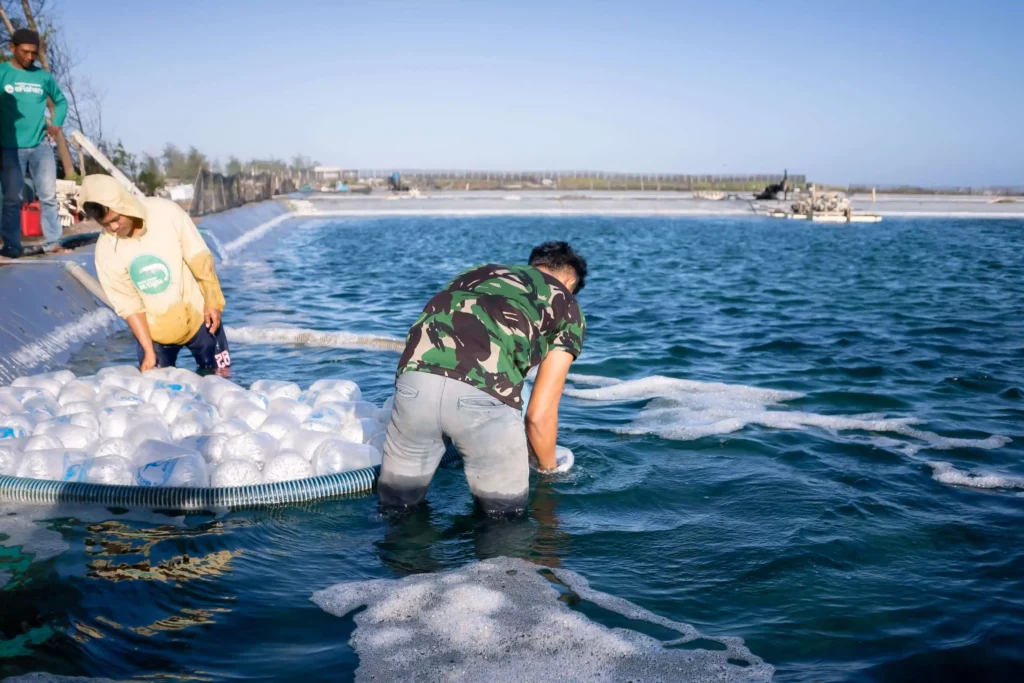
After you know the characteristics of good quality fry and how to spread them, you also need to add insight into the things that need to be considered when stocking vannamei shrimp fry. There are 6 important things that you need to do before sowing shrimp fry into shrimp ponds, see the reviews:
- Making sure the pool is ready
Before sowing fry, you must ensure that the pond is ready for spreading vannamei shrimp fry. The readiness of the pond in question can be seen from the water quality parameters suitable for fry growth. - Benur Check
You should check the fry first before spreading them into the pond. Make sure the fry have a certificate Specific Pathogen Free (SPF) and Specific Pathogen Resistant (SPR).SPF fries are fry that are sterile and free from pathogens, such as viruses that cause WSSV, TSV, IMNV, and IHHNV. Meanwhile, SPR shows the genetic character of fry that is resistant to this pathogen. - sampling Benur
You need to do sampling fry before sowing them in ponds. sampling done at least 10% of the total fry. That way, you can find out the quality of the fry without having to check them one by one. - Water Quality Check
The process of stocking fry will run more easily and quickly when the temperature and salinity differences in the fry packaging with pond water are not too far apart. The temperature difference should be no more than 2℃ and the maximum difference in salinity is 5 ppt. - Benur Physical Condition Check
The physical conditions of the fry that were checked were necrosis and the stability of the fry which were carried out in the laboratory. The necrosis test aims to determine how much cell death occurs in fry organs. Necrosis is characterized by the accumulation of epithelial cells in the tubules which are dark to reddish in color.
Meanwhile, bolitas is marked by the tissue of the fry hepatopancreas which turns into balls. The finding of bolitas indicates abnormalities in the organs of the fry. This happens due to fry experiencing stress. - Calculation of the Number of Benur
This process is important to do because it is related to the stocking density of each pond. If you sow fry beyond the stocking density requirements, it will certainly have an impact on carrying capacity pool. Calculations are simply carried out on the selected bag at the time sampling. The tools used are large buckets, small buckets, hand tally counter (manual counting tool), and scoop.
How to calculate the number of fry is quite easy, here are the reviews:
- Pour all the fry into a large bucket.
- Take the fry using a ladle.
- Count the live fry.
- Move the fry that have been counted into a small bucket.
- Fry fry can be stocked in ponds according to the desired stocking density.
Strategy for Spreading Vannamei Shrimp Fry During Extreme Weather
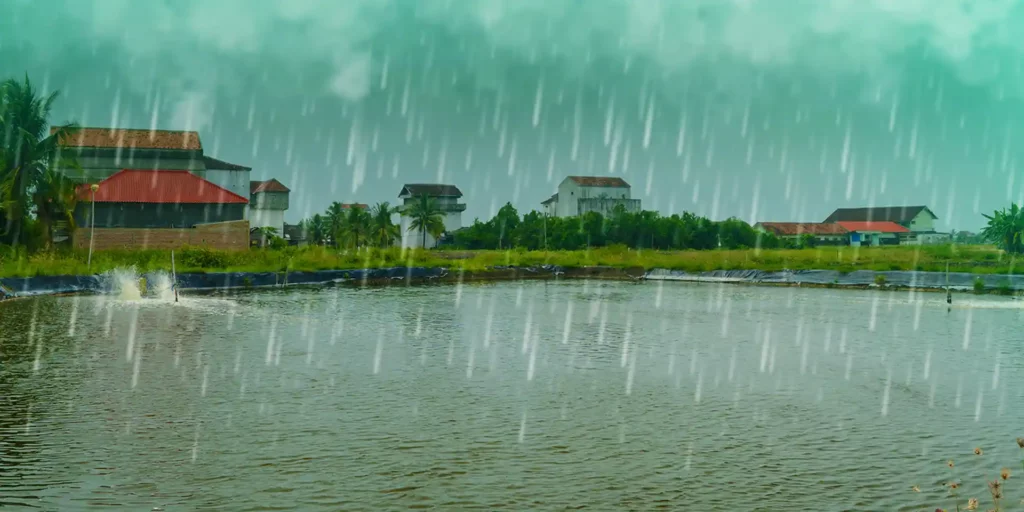
The quality of pond water is closely related to the health conditions of the shrimp, the quality of pond water will support the optimal growth and development of vannamei shrimp. The following is a strategy for spreading vannamei shrimp fry during extreme weather:
- Dry season
The dry season will result in changes in water quality parameters such as increased temperature and salinity. Therefore, before sowing shrimp fry in ponds, you are advised to check the quality of the pond water.
An increase in pond water temperature during the dry season can cause stress for shrimp fry. The effort that you can do is to increase the number of waterwheels to optimize the temperature of the pond. The addition of a wheel can also increase the supply of dissolved oxygen in the water.
In the dry season, pond water conditions will become hypersaline or high salt content. The effort that you can do is to add fresh water. Apart from that, you can also reduce the number of fry in the pond. This is to prevent competition for oxygen and fry fry to move more freely. - Rainy season
The rainy season will affect water quality and trigger bacterial populations in ponds. Spreading shrimp fry during the rainy season tends to be more risky. Water quality is becoming more volatile, while shrimp are still fry which are susceptible to disease.
The following is the strategy for spreading vaname shrimp fry during the rainy season:- Make sure the drain is ready to handle the high volume of water caused by rain.
- Discard the pond surface water and make sure the mill continues to operate.
- Spread lime around the pool to control the pH of the water.
- Maximize the use of aerators and make sure DO > 4 ppm.
- Monitoring microalgae and bacteria populations.
- Aplikasikan probiotik agar tidak ada bakteri merugikan dalam tambak.
- Transition season
During the transition season, the hot-cold combination makes the pool water temperature fluctuate. Uncertain rainfall will affect the balance of water conditions both pH and temperature. The strategy for stocking fry that you can do is to reduce the stocking density of the fry. This step is the easiest to do and reduces the possibility of crop failure. Not only that, the fry will move more freely in the pond because their density is low.
In addition, you can maintain temperature stability. Changes in water temperature can stress fry and decrease their immune system, making them more susceptible to disease and even death. The increased temperature will make the bacteria grow faster in the pond. The right way that you can do is to drain pond water and use a waterwheel to increase oxygen levels in the pond.
Get the Right Way to Spread Vaname Shrimp Benur Through Free Cultivation Consultations at eFarm
Need Help Regarding Shrimp Cultivation Business?
Fill in your personal data in the following form. Our team will immediately contact you via the number cellphone attached. Make sure the data entered is correct.
The method of spreading vannamei shrimp needs to be done correctly and correctly, because it will affect the shrimp harvest. However, if you are still confused about how to spread fry, you can consult the problem of spreading vannamei shrimp fry through eFarm.
eFarm is an application that can make your shrimp cultivation process more efficient with the help of technology. This app provides features Cultivation Consultation make it easier for you to get solutions to shrimp farming problems.
With this feature, you can consult with a cultivation expert and get complete and proper steps for caring for shrimp farming. Not only that, this feature can be accessed for FREE! Very interesting isn't it?
Visit eFarm now, to join tens of thousands of other Shooters!

Eko Afriantoro - Praktisi Budidaya Udang
Eko berpengalaman sebagai praktisi budidaya udang sejak tahun 2013 yang kini menjadi Farm Lead Research & Development (R&D) Shrimp eFishery.
Questions About How to Spread Vaname Shrimp Benur
The steps for spreading the vaname shrimp fry consist of floating the bag of fry in the pond, acclimatizing to temperature, acclimatizing to salinity, and letting the fry swim out on their own.
Acclimatization aims to allow the fry to adapt to the pond environment and to prevent the high mortality rate during and after stocking.
Acclimatization lasts for 15-30 minutes depending on the temperature adjustment between the plastic fry and the pond environment.
- Ghufron M, Lamid M, Sari PDW, and Suprapto H. 2017. Vaname Shrimp Enlargement Technique (Litopenaeus vannamei) on PT Central Proteina Prima Tbk Assistance Pond in Randutatah Village, Paiton District, Probolinggo, East Java. Journal of Aquaculture and Fish Health. 7(2): 70-77.
- Syah R, Makmur, and Fahrur M. 2017. Vaname Shrimp Cultivation with High Stocking Density. Aquaculture Media Journal. 12(1): 19-26.
- Scabra AR, Satria I, Marzuki M, and Setyono BDH. 2021. The Effect of Different Acclimatization Times on the Survival and Growth of Vaname Shrimp (Litopenaeus vannamei). Fisheries Journal. 11(1):120-128.
- https://www.benurtop.com/post/ciri-benur-udang-sehat-dan-berkualitas-unggul
